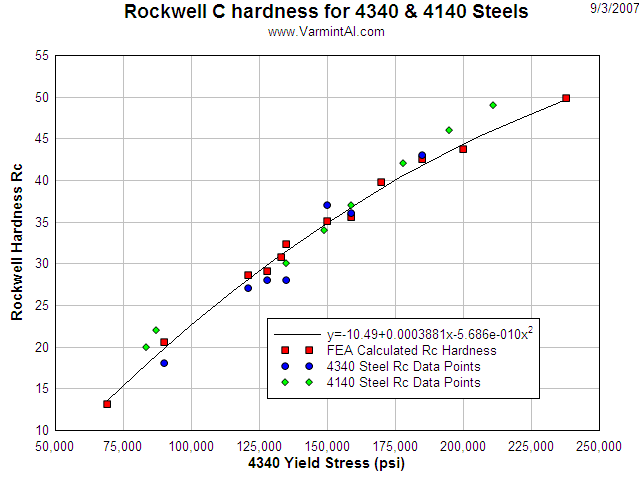

POWERFUL TOOL.... The NIKE2D Finite Element Code by Livermore Software Technology Corp is a very powerful 2-D tool for calculating the loads and deformations of axisymmetric structures. Often, I need to know the yield and ultimate stress of materials when given only the Rockwell C hardness. NIKE2D can be used to calculate the Rockwell C hardness of various materials in the material.txt data base. Being able to calculate the Rockwell C hardness of a steel is very useful in selecting the correct material properties for a material of interest.
THE MEASUREMENTS.... I have generated a 2-D FEA model of the the Rockwell hardness testing procedure. The diamond cone, used for the Rockwell C hardness testing, has a 120 degree included angle with a 0.02 mm tip radius. In the calculation, the loading is identical to the actual test procedure. A 10 Kg load is applied to the diamond, the displacement if the diamond indenter is recorded and then the load is increased to 150 Kg. The load is then decreased back down to 10 Kg and the displacement of the diamond is again recorded. These two measurements are used to calculate the Rockwell C hardness. A friction coefficient of 0.2 is used between the diamond surface and the steel.
THE MATH.... The difference of the first 10 Kg load depth and the second 10 Kg depth, measured in millimeters divided by 0.002 mm and then subtracted from 100 is the Rockwell C hardness.
Rc = 100 - (Y2 - Y1) / 0.002
|
1. The diamond cone is loaded to 10 Kg and the vertical
displacement is recorded (Y1). |
Table 1: Hardness numbers for 4340 Steel in various heat treat conditions.
| Steel 4340 Yield Stress (psi) |
Nominal Rockwell C |
Calculated Rockwell C u=0.2 |
Nominal Brinell Hardness |
Calculated Brinell Hardness |
| 69,000 | 13.07 | 217 | ||
| 90,000 | 18 | 20.54 | 220 | |
| 121,000 | 27 | 28.65 | ||
| 128,000 | 28* | 29.12 | 270 | |
| 133,000 | 30.72 | |||
| 135,000 | 28* | 32.33 | 310 | |
| 150,000 | 37 | 35.07 | 340 | |
| 159,000 | 36 | 35.54 | ||
| 170,000 | 39.70 | 380 | ||
| 185,000 | 43 | 42.47 | 400 | |
| 200,000 | 43.69 | 430 | ||
| 238,000 | 49.86 | 550 | ||
u = 0.2 is the friction coefficient between the diamond and
the test metal.
* The available data is obviously not very accurate in the midrange of yield
stresses.

The Rc calculated hardness fits the available data reasonably well.
When time allows, I will generate another FEA model to calculate the Brinell hardness metals. I recently found data on 4140 steel and added it to the plot. The calculations were only for 4340 steel, but they look very similar.
Material Name and Condition. Density Yng's Poiss Yld Ult Elong Redu CTE Yld
lb/in^3 Modul Ratio Strs Strs % Area 10^-6 off-
msi ksi ksi % /degF set
steel wrought 4340 1 in. bar annealed 0.2830 30.00 0.290 69.0 108.0 22.0 50.0 6.30 0.20
steel wrought 4340 Case 1 0.2830 30.00 0.290 90.0 117.8 21.4 54.0 6.30 0.20
steel wrought 4340 Case 2 0.2830 30.00 0.290 128.0 143.2 18.4 56.0 6.30 0.20
steel wrought 4340 1 in. bar oq+1200f 0.2830 30.00 0.290 133.0 147.0 18.0 57.0 6.30 0.20
steel wrought 4340 Case 3 0.2830 30.00 0.290 135.0 149.1 17.7 54.0 6.30 0.20
steel wrought 4340 Case 4 0.2830 30.00 0.290 150.0 163.2 16.8 53.0 6.30 0.20
steel wrought 4340 0.2840 29.70 0.290 159.0 165.0 16.5 54.1 6.83 0.20
steel wrought 4340 1 in. bar oq+1200f 0.2830 30.00 0.290 170.0 183.0 14.0 52.0 6.30 0.20
steel wrought 4340 Case 5 0.2830 30.00 0.290 185.0 203.0 12.9 48.0 6.30 0.20
steel wrought 4340 1 in. bar oq+800f 0.2830 30.00 0.290 200.0 222.0 12.0 47.0 6.30 0.20
steel wrought 4340 1 in. bar oq+400f 0.2830 30.00 0.290 238.0 283.0 11.0 48.0 6.30 0.20
steel wrought 4140 1 in. bar annealed 0.2830 29.00 0.290 61.0 95.0 26.0 57.0 6.20 0.20
steel wrought 4140 1 in. bar norm 0.2830 29.00 0.290 95.0 148.0 18.0 47.0 6.20 0.20
steel wrought 4140 1 in. bar oq+1200f 0.2830 30.00 0.290 95.0 110.0 18.0 53.0 6.20 0.20
steel wrought 4140 1 in. bar oq+1000f 0.2830 30.00 0.290 143.0 165.0 15.0 50.0 6.20 0.20
steel wrought 4140 1 in. bar oq+400f 0.2830 30.00 0.290 238.0 257.0 8.0 38.0 6.20 0.20
Last Updated: 02/08/2013
End of Page![]()